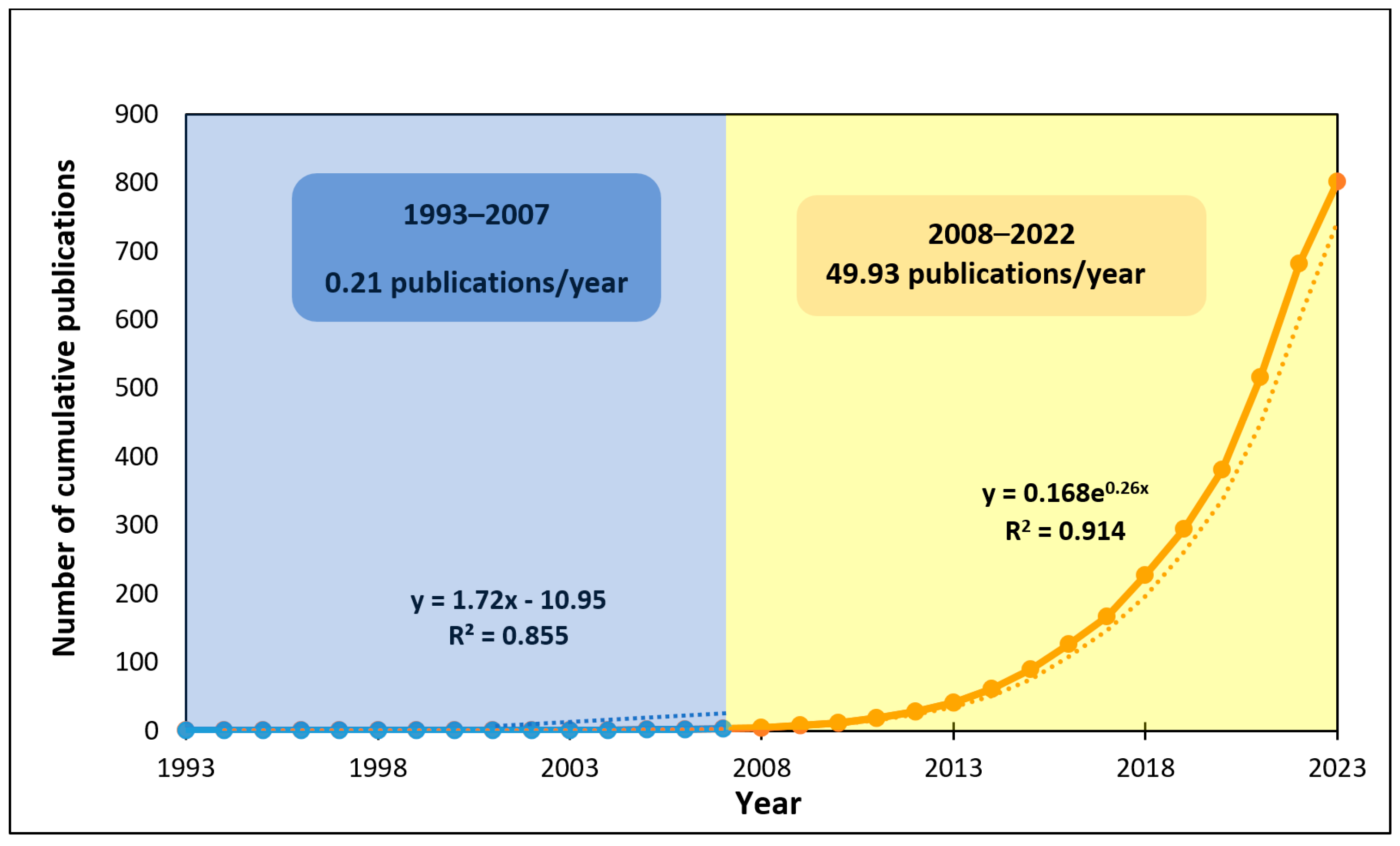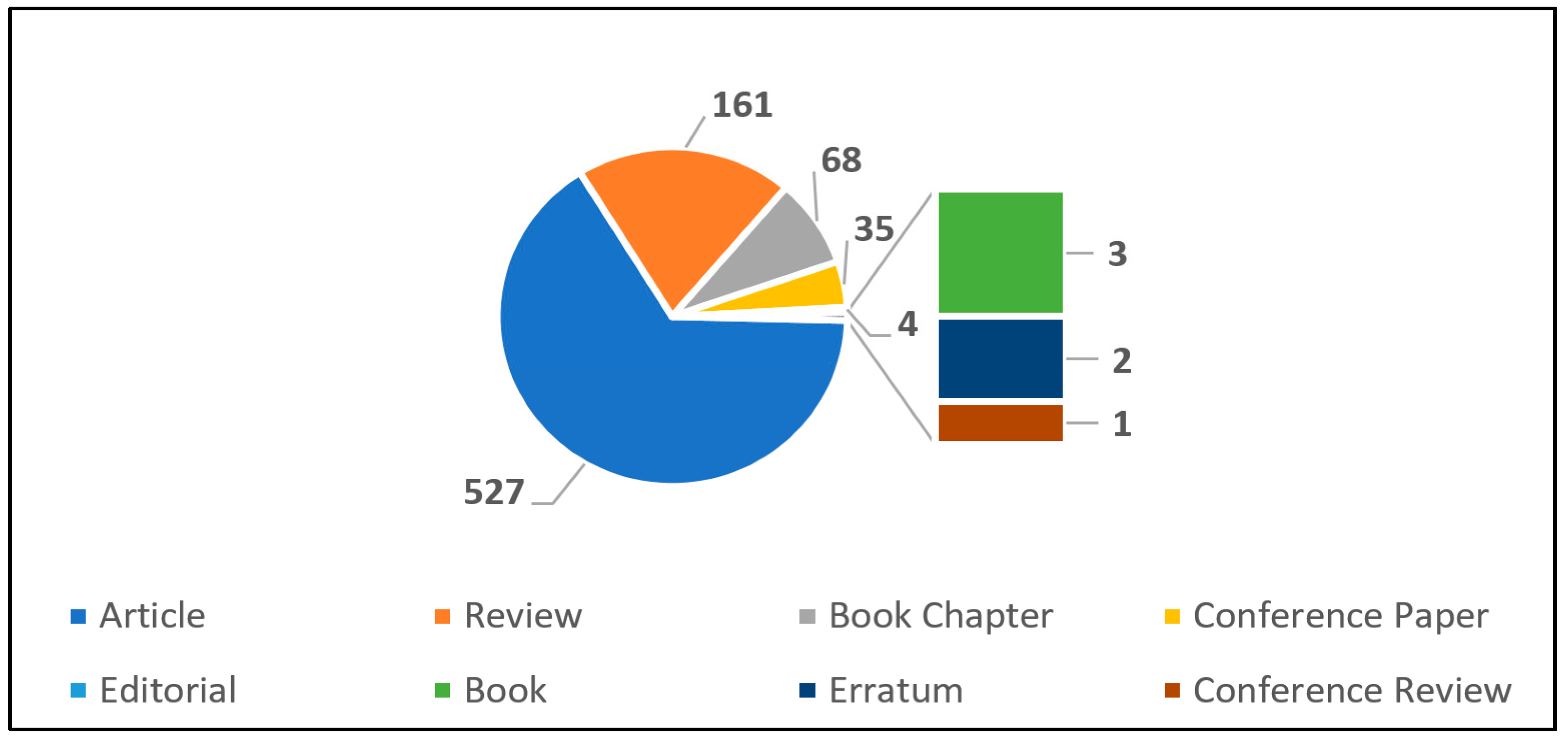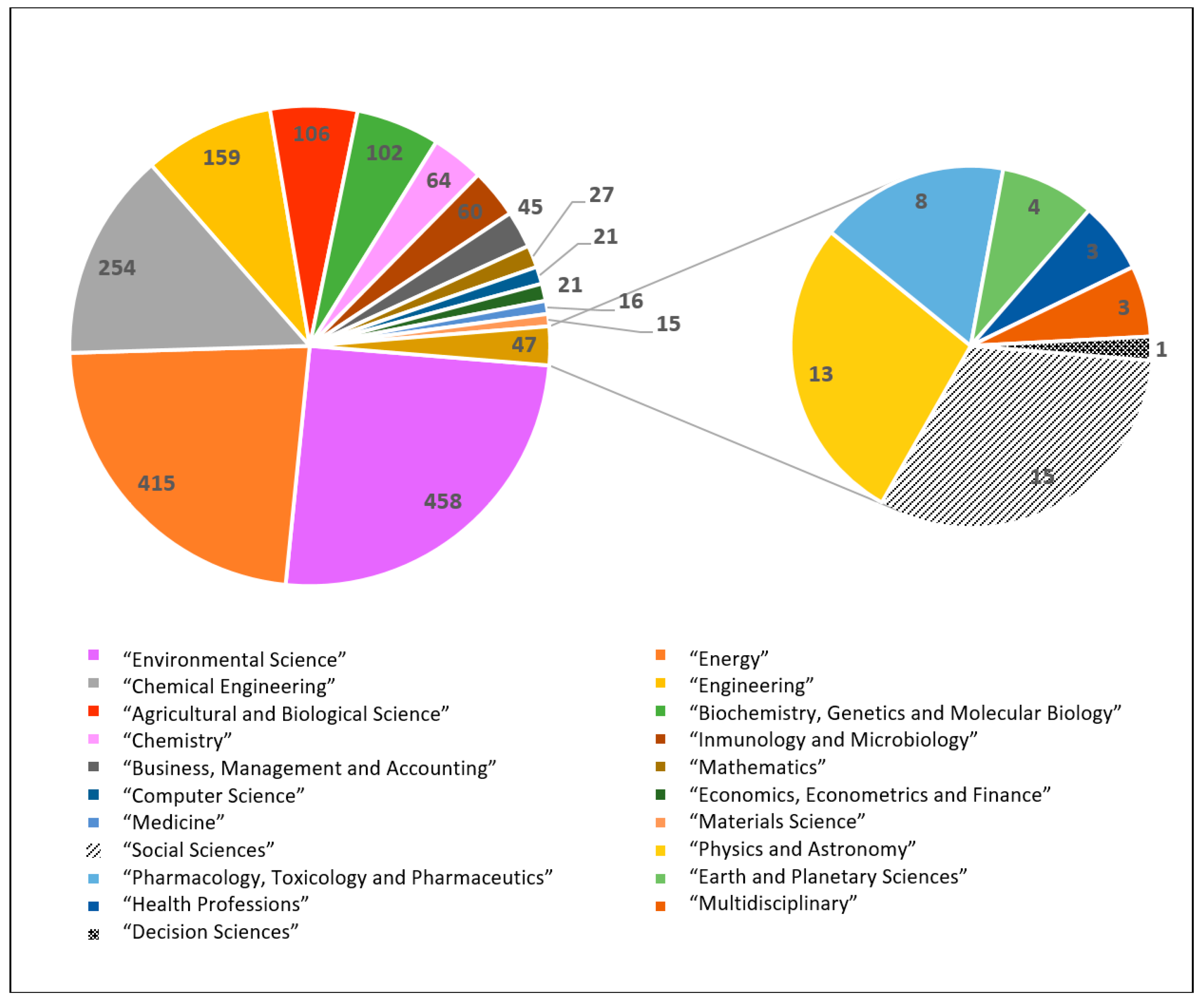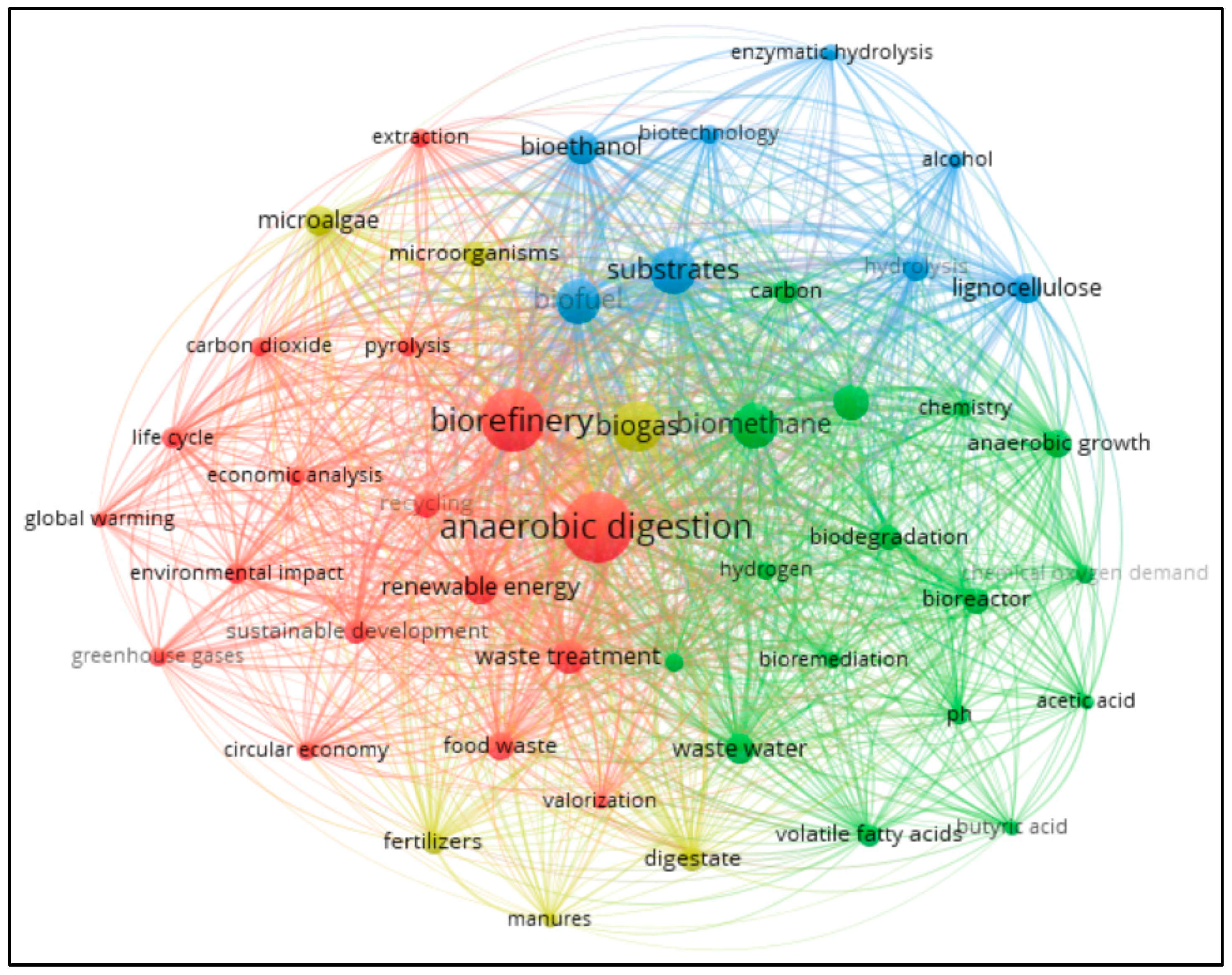Research Trends in the Recovery of By-Products from Organic Waste Treated by Anaerobic Digestion: A 30-Year Bibliometric Analysis
Abstract
:1. Introduction
2. Materials and Methods
3. Results
3.1. Topic’s Publication Growth
3.2. Keyword Analysis
4. Discussion
4.1. General and Beneficial Aspects of Waste Valorisation
4.2. Volatile Fatty Acids and Biohydrogen as Anaerobic Digestion By-Products
4.3. Lignocellulosic Substrates and Their By-Products
4.4. Main Products of Anaerobic Digestion: Biogas and Digestate
4.5. Future Perspectives
5. Conclusions
Author Contributions
Funding
Institutional Review Board Statement
Informed Consent Statement
Data Availability Statement
Acknowledgments
Conflicts of Interest
References
- FAO. The State of Food and Agriculture 2023. 2023. Available online: https://openknowledge.fao.org/items/d8b6b6d9-4fe3-4589-8b88-cac3f9ccdf0f (accessed on 24 June 2024).
- United Nations Environment Programme, Food Waste Index Report 2024. Think Eat Save: Tracking Progress to Halve Global Food Waste. Available online: https://wedocs.unep.org/20.500.11822/45230 (accessed on 18 July 2024).
- Decision (EU) 2022/591 of the European Parliament and of the Council of 6 April 2022 on a General Union Environmental Action Programme to 2030. Available online: http://data.europa.eu/eli/dec/2022/591/oj (accessed on 26 June 2024).
- CEAP. European’s Circular Economy Action Plan. 2020. Available online: https://environment.ec.europa.eu/strategy/circular-economy-action-plan_en (accessed on 4 June 2024).
- European Union. European Green Deal. 2019. Available online: https://commission.europa.eu/strategy-and-policy/priorities-2019-2024/european-green-deal_en (accessed on 24 June 2024).
- NIECP. Integrated National Energy and Climate Plan 2021–2030. 2021. Available online: https://energy.ec.europa.eu/system/files/2020-06/es_final_necp_main_en_0.pdf (accessed on 4 June 2024).
- Zeng, C.; Ma, R.; Chen, P. Impact of mineral resource rents and fin-tech on green growth: Exploring the mediating role of environmental governance in developed economies. Resour. Policy 2024, 89, 104547. [Google Scholar] [CrossRef]
- United Nations. Transforming Our World: The 2030 Agenda for Sustainable Development. 2015. Available online: https://sustainabledevelopment.un.org/content/documents/21252030%20Agenda%20for%20Sustainable%20Development%20web.pdf (accessed on 4 June 2024).
- Sánchez, G.M.M. Digestión Anaerobia; UADY: Mérida, Mexico, 1996; Volume 1. [Google Scholar]
- Sawatdeenarunat, C.; Surendra, K.; Takara, D.; Oechsner, H.; Khanal, S.K. Anaerobic digestion of lignocellulosic biomass: Challenges and opportunities. Bioresour. Technol. 2015, 178, 178–186. [Google Scholar] [CrossRef] [PubMed]
- Wagemann, K.; Tippkötter, N. Biorefineries: A Short Introduction. In Biorefineries; Wagemann, K., Tippkötter, N., Eds.; Springer: Berlin/Heidelberg, Germany, 2019; pp. 1–11. [Google Scholar]
- Donthu, N.; Kumar, S.; Mukherjee, D.; Pandey, N.; Lim, W.M. How to conduct a bibliometric analysis: An overview and guidelines. J. Bus. Res. 2021, 133, 285–296. [Google Scholar] [CrossRef]
- Garrido-Cardenas, J.A.; Manzano-Agugliaro, F.; Acien-Fernandez, F.G.; Molina-Grima, E. Microalgae research worldwide. Algal Res. 2018, 35, 50–60. [Google Scholar] [CrossRef]
- Yazdani, S.S.; Gonzalez, R. Anaerobic fermentation of glycerol: A path to economic viability for the biofuels industry. Curr. Opin. Biotechnol. 2007, 18, 213–219. [Google Scholar] [CrossRef] [PubMed]
- Millati, R.; Wikandari, R.; Ariyanto, T.; Hasniah, N.; Taherzadeh, M.J. Anaerobic digestion biorefinery for circular bioeconomy development. Bioresour. Technol. Rep. 2022, 21, 101315. [Google Scholar] [CrossRef]
- Piadeh, F.; Offie, I.; Behzadian, K.; Rizzotu, J.P.; Bywater, A.; Córdoba-Pachón, J.R.; Waler, M. A critical review for the impact of anaerobic digestion on the sustainable development goals. J. Environ. Manag. 2024, 349, 119458. [Google Scholar] [CrossRef]
- Sarangi, P.K.; Vivekanand, V.; Mohanakrishna, G.; Pattnaik, B.; Muddapur, U.M.; Aminabhavi, T.M. Production of bioactive phenolic compounds from agricultural by-products towards bioeconomic perspectvies. J. Clean. Prod. 2023, 414, 137460. [Google Scholar] [CrossRef]
- Cheng, P.; Li, Y.; Wang, C.; Guo, J.; Zhou, C.; Zhang, R.; Ma, Y.; Ma, X.; Wang, L.; Cheng, Y.; et al. Integrated marine microalgae biorefineries for improved bioactive compounds: A review. Sci. Total Environ. 2022, 817, 152895. [Google Scholar] [CrossRef]
- Xu, Q.; Zhang, T.; Niu, Y.; Mukherjee, S.; Abou-Elwafa, S.F.; Nguyen, N.S.H.; Al Aboud, N.M.; Wang, Y.; Pu, M.; Zhang, Y.; et al. A comprehensive review on agricultural waste utilization through sustainable conversion techniques, with a focus on the additives effect on the fate of phosphorous and toxic elements during composting process. Sci. Total Environ. 2024, 942, 173567. [Google Scholar] [CrossRef]
- Sikiru, S.; Abioye, K.J.; Adedayo, H.B.; Adebukola, S.Y.; Soleimani, H.; Anar, M. Technology projection in biofuel production using agricultural waste materials as a source of energy sustainability: A comprehensive review. Renew. Sustain. Energy Rev. 2024, 200, 114535. [Google Scholar] [CrossRef]
- Koubaa, M. Integrated biorefinery for a next-generation methanization process focusing on volatile fatty acids valorization: A critical review. Molecules 2024, 29, 2477. [Google Scholar] [CrossRef]
- De la Lama-Calvente, D.; Fernández-Rodríguez, M.J.; García-Gómez, J.C.; Borja, R. Impact of natural degradation of the invasive alga Rugulopteryx okamurae on anaerobic digestion: Heavy metal pollution and kinetic performance. Mar. Pol. Bull. 2023, 192, 115005. [Google Scholar] [CrossRef] [PubMed]
- Tsui, T.H.; van Loosdrecht, M.C.M.; Dai, Y.; Tong, Y.W. Machine learning and circular bioeconomy: Building new resource efficiency from diverse waste streams. Bioresour. Technol. 2023, 369, 128445. [Google Scholar] [CrossRef] [PubMed]
- Gracia, J.; Cabeza, I.; Acevedo, P. Life cycle análisis for the production of volatile fatty acids from wastewater treatment plant sludge. Cogent Eng. 2024, 11, 2335846. [Google Scholar] [CrossRef]
- Žganjar, M.; Ogrizović, M.; Matul, M.; Čadež, N.; Gunde-Cimerman, N.; González-Fernández, C.; Gostinčar, C.; Tomás-Pejó, E.; Pretrovič, U. High-throughput screening of non-conventional yeasts for conversión of organic waste to microbial oils via carboxylate platform. Sci. Rep. 2024, 14, 14233. [Google Scholar] [CrossRef]
- Sun, S.; Wang, X.; Cheng, S.; Lei, Y.; Sun, W.; Wang, K.; Li, Z. A review of volatile fatty acids production from organic wastes: Intensification techniques and separation methods. J. Environ. Manag. 2024, 360, 121062. [Google Scholar] [CrossRef]
- Cubero-Cardoso, J.; Russo, E.; Serrano, A.; Trujillo-Reyes, A.; Villa-Gomez, D.; Esposito, G.; Fermoso, F.G. Enhancing the recovery of volatile fatty acids from strawberry extrudate through anaerobic fermentation at different pH values. Environ. Technol. Innov. 2022, 28, 102587. [Google Scholar] [CrossRef]
- Wang, K.; Yin, J.; Shen, D.; Li, N. Anaerobic digestion of food waste for volatile fatty acids (VFAs) production with different types of inoculum: Effect of pH. Bioresour. Technol. 2014, 161, 395–401. [Google Scholar] [CrossRef]
- Fernandez-Dominguez, D.; Astals, S.; Peces, M.; Frison, N.; Bolzonella, D.; Mata-Alvarez, J.; Dosta, J. Volatile fatty acids production from biowaste at mechanical-biological treatment plants: Focusing on fermentation temperature. Bioresour. Technol. 2020, 314, 123729. [Google Scholar] [CrossRef]
- Liu, S.; Hou, J.; Zhang, S.; Zhang, X.; Zhang, Q. The transformation of heavy metal speciation during rapid high-temperature aerobic fermentation of food waste and their potential mechanisms. J. Environ. Manag. 2023, 346, 119030. [Google Scholar] [CrossRef]
- Sarkar, O.; Venkata Mohan, S. Pre-aeration of food waste to augment acidogenic process at higher organic load: Valorizing biohydrogen, volatile fatty acids and biohythane. Bioresour. Technol. 2017, 242, 68–76. [Google Scholar] [CrossRef] [PubMed]
- Parchami, M.; Wainaina, S.; Mahboubi, A.; I’Ons, D.; Taherzadeh, M.J. MBR assisted VFAs production from excess sewage sludge and food waste slurry for sustainable wastewater treatment. Appl. Sci. 2020, 10, 2921. [Google Scholar] [CrossRef]
- Albuquerque, M.M.; Martinez-Burgos, W.J.; Sartor, G.D.B.; Letti, L.A.J.; De Carvalho, J.C.; Soccol, C.R.; Medeiros, A.B.P. Advances and perspectives in biohydrogen production from palm oil mill effluent. Fermentation 2024, 10, 141. [Google Scholar] [CrossRef]
- Rashidi, M.; Alavi, N.; Amereh, F.; Rafiee, M.; Amanidaz, N.; Partovi, K.; Mosanefi, S.; Bakhshoodeh, R. Biohydrogen production from co-digestion of sugarcane vinasse and bagasse using anaerobic dark fermentation. Bioresour. Technol. Rep. 2024, 25, 101793. [Google Scholar] [CrossRef]
- Łukajtis, R.; Hołowacz, I.; Kucharska, K.; Glinka, M.; Rybarczyk, P.; Przyjazny, A.; Kami’nski, M. Hydrogen production from biomass using dark fermentation. Renew. Sustain. Energy Rev. 2018, 91, 665–694. [Google Scholar] [CrossRef]
- Garritano, A.N.; Faber, M.d.O.; de Sà, L.R.V.; Ferreira-Leitão, V.S. Palm Oil Mill Effluent (POME) as raw material for biohydrogen and methane production via dark fermentation. Renew. Sustain. Energy Rev. 2018, 92, 676–684. [Google Scholar] [CrossRef]
- Clark, I.C.; Zhang, R.H.; Upadhyaya, S.K. The effect of low pressure and mixing on biological hydrogen production via anaerobic fermentation. Int. J. Hydrog. Energy 2012, 37, 11504–11513. [Google Scholar] [CrossRef]
- Sahrin, N.T.; Khoo, K.S.; Lim, J.H.; Shamsuddin, R.; Ardo, F.; Rawindran, H.; Hassan, M.; Kiatkittipong, W.; Abdelfattah, E.; Da Oh, W.; et al. Current perspectives, future challenges and key technologies of biohydrogen production for building a carbon–neutral future: A review. Bioresour. Technol. 2022, 364, 128088. [Google Scholar]
- Forde, G.M.; Rainey, T.J.; Speight, R.; Batchelor, W.; Pattenden, L.K. Matching the biomass to the bioproduct Summary of up-and downstream bioprocesses. Phys. Sci. Rev. 2016, 46, 20160046. [Google Scholar]
- Zhang, H.; Xue, K.; Wang, B.; Ren, W.; Sun, D.; Shao, C.; Sun, R. Advances in lignin-based biosorbents for sustainable wastewater treatment. Bioresour. Technol. 2024, 395, 130347. [Google Scholar] [CrossRef]
- Khanal, S.K. Anaerobic Biotechnology for Bioenergy Production: Principles and Application; Willey and Blackwell, John Wiley & Son Inc.: Ames, IA, USA, 2008; pp. 161–186. [Google Scholar]
- Hennessey-Ramos, L.; Cisneros-Yupanqui, M.; Santisteban-Sato, D.V.; Lante, A.; Favaro, L.; Casella, S.; Basaglia, M. Exploitation of cocoa pod residues for the production off antioxidants, polyhydroxylalkaonates, and ethanol. Fermentation 2023, 9, 843. [Google Scholar] [CrossRef]
- Saratale, R.G.; Ponnusamy, V.K.; Piechota, G.; Igliński, B.; Shobbana, S.; Park, J.H.; Saratale, G.D.; Shin, H.S.; Banu, J.R.; Kumar, V.; et al. Green chemical and hybrid enzymatic pretreatments for lignocellulosic biorefineries: Mechanism and challenges. Bioresour. Technol. 2023, 387, 129560. [Google Scholar] [CrossRef]
- Reshmy, R.; Philip, E.; Madhavan, A.; Sirohi, R.; Pugazhendhi, A.; Binod, P.; Awasthi, M.K.; Vivek, N.; Kumar, V.; Sindhu, R. Lignocellulose in future biorefineries: Strategies for cost-effective production of biomaterials and bioenergy. Bioresour. Technol. 2021, 344, 126241. [Google Scholar] [CrossRef]
- Kuila, A.; Sharma, V.; Garlapati, V.K.; Singh, A.; Roy, L.; Banerjee, R. Present statu s on enzymatic hydrolysis of lignocellulosic biomass for bioethanol production. Adv. Biofeedstocks Biofuels 2016, 1, 85. [Google Scholar]
- Cheah, W.Y.; Er, A.C.; Aiyub, K.; Yasin, N.H.M.; Ngan, S.L.; Chew, K.W.; Show, P.L. Current status and perspectives of algae-based bioplastics: A reviewed potential for sustainability. Algal Res. 2023, 71, 103078. [Google Scholar] [CrossRef]
- Bhatia, S.K.; Otari, S.V.; Jeon, J.M.; Gurav, R.; Choi, Y.K.; Bhatia, R.K.; Yang, Y.H. Biowaste-to-bioplastic (polyhydroxyalkanoates): Conversion technologies, strategies, challenges, and perspective. Bioresour. Technol. 2021, 326, 124733. [Google Scholar] [CrossRef] [PubMed]
- Amara, A.A.; El-Baky, N.A. Fungi as a source of edible proteins and animal feed. J. Fungi 2023, 9, 73. [Google Scholar] [CrossRef] [PubMed]
- Cherubini, F.; Strømman, A.H. Chemicals from lignocellulosic biomass: Opportunities, perspectives, and potential of biorefinery systems. Biofuels Bioprod. Biorefining 2011, 5, 548–561. [Google Scholar] [CrossRef]
- Velvizhi, G.; Jacqueline, P.J.; Shetti, N.P.; Latha, K.; Mohanakrishna, G.; Aminabhavi, T.M. Emerging trends and advances in valorization of lignocellulosic biomass to biofuels. J. Environ. Manag. 2023, 345, 118527. [Google Scholar] [CrossRef]
- Ma, X.; Chen, J.; Zhu, J.; Yan, N. Lignin-based polyurethane: Recent advances and future perspectives. Macromol. Rapid Comm. 2021, 42, 2000492. [Google Scholar] [CrossRef]
- Sun, S.C.; Xu, Y.; Wen, J.L.; Yuan, T.Q.; Sun, R.C. Recent advances in lignin-based carbon fibers (LCFs): Precursors, fabrications, properties, and applications. Green Chem. 2022, 24, 5709–5738. [Google Scholar] [CrossRef]
- Alinejad, M.; Henry, C.; Nikafshar, S.; Gondaliya, A.; Bagheri, S.; Chen, N.; Nejad, M. Lignin-based polyurethanes: Opportunities for bio-based foams, elastomers, coatings and adhesives. Polymers 2019, 11, 1202. [Google Scholar] [CrossRef] [PubMed]
- Lytras, G.M.; Lytras, C.; Mathioudakis, D.; Papadopoulou, K.; Lyberatos, G. Food waste valorization based on anaerobic digestion. Waste Biomass Valor. 2021, 12, 1677–1697. [Google Scholar] [CrossRef]
- Kougias, P.; Angelidaki, I. Biogas and its opportunities—A review. Front. Environ. Sci. Eng. 2018, 12, 1–12. [Google Scholar]
- Cellek, M.S.; Demir, U.; Coskun, G. Investigation effects of different calorific values and operating conditions on biogas flame: A CFD study. Energy Sources Part A Recovery Util. Environ. Eff. 2024, 46, 8171–8189. [Google Scholar] [CrossRef]
- Galloni, M.; Di Marcoberardino, G. Biogas upgrading technology: Conventional processes and emerging solutions analysis. Energies 2024, 17, 2907. [Google Scholar] [CrossRef]
- Balagurusamy, N.; Chandel, A.K. Biogas Production: From Anaerobic Digestion to a Sustainable Bioenergy Industry; Springer Nature: Berlin/Heidelberg, Germany, 2021. [Google Scholar]
- Nagarajan, D.; Lee, D.; Chang, J.S. Integration of anaerobic digestion and microalgal cultivation for digestate bioremediation and biogas upgrading. Bioresour. Technol. 2019, 290, 121804. [Google Scholar] [CrossRef]
- Fernández-Rodríguez, M.J.; De La Lama-Calvente, D.; García-González, M.; Moreno-Fernández, J.; Jiménez-Rodríguez, A.; Borja, R.; Rincón-Llorente, B. Integral valorization of two-phase olive mill solid waste (OMSW) and related washing waters by anaerobic co-digestion of OMSW and the microalga Raphidocelis subcapitata cultivated in these effluents. J. Agric. Food Chem. 2022, 70, 3219–3227. [Google Scholar] [CrossRef]
- Rao, M.U.; Vidyasagar, D.; Rangappa, H.S.; Subrahmanyam, C. Recent advances on CO2 conversion into value added fuels by non-thermal plasma. Catal. Today 2024, 441, 114887. [Google Scholar] [CrossRef]
- García, J.; Sialve, B.; Trably, E.; Steyer, J.; Uggetti, E. Integrating microalgae production with anaerobic digestion: A biorefinery approach. Biofuels Bioprod. Biorefining 2014, 8, 516–529. [Google Scholar]
- Alburquerque, J.A.; De La Fuente, C.M.R.; Ferrer-Costa, A.; Carrasco, L.; Cegarra, J.; Abad, M.; Bernal, M. Assessment of the fertiliser potential of digestates from farm and agroindustrial residues. Biomass Bioenergy 2012, 40, 181–189. [Google Scholar] [CrossRef]
- Rakib, M.R.J.; Jolly, Y.N.; Dioses-Salinas, D.C.; Pizarro-Ortega, C.I.; De-la-Torre, G.E.; Khandaker, M.U.; Alsubaie, A.; Almalki, A.S.A.; Bradley, D.A. Macroalgae in biomonitoring of metal pollution in the bay of Bengal coastal waters of Cox’s Bazar and surrounding areas. Sci. Rep. 2021, 11, 20999. [Google Scholar] [CrossRef]
- van Midden, C.; Harris, J.; Show, L.; Sizmur, T.; Pawlett, M. The impact of anaerobic digestate on soil life: A review. Appl. Soil Ecol. 2023, 191, 105066. [Google Scholar] [CrossRef]
- Catenacci, A.; Boniardi, G.; Mainardis, M.; Gievers, F.; Farru, G.; Asunis, F.; Malpei, F.; Goi, D.; Cappai, G.; Canziani, R. Processes, applications and Chapter 6 | Valorization of digestate as a b 25 legislative framework for carbonized anaerobic digestate: Opportunities and bottlenecks. A critical review. Energy Conv. Manag. 2022, 263, 115691. [Google Scholar] [CrossRef]
- Chojnacka, K.; Chojnacki, M. Nutrient recovery from anaerobic digestate: Fertiliser informatics for circular economy. Environ. Res. 2024, 245, 117953. [Google Scholar] [CrossRef]
- Delrue, F.; Setier, P.A.; Sahut, C.; Cournac, L.; Roubaud, A.; Peltier, G.; Froment, A. An economic, sustainability, and energetic model of biodiesel production from microalgae. Bioresour. Technol. 2012, 111, 191–200. [Google Scholar] [CrossRef]
- Fagerström, A.; Al Seadi, T.; Rasi, S.; Briseid, T. The Role of Anaerobic Digestion and Biogas in the Circular Economy; Murphy, J.D., Ed.; IEA Bioenergy Task: Cork, Ireland, 2018; p. 37. [Google Scholar]
- Makepa, D.C.; Chihobo, C.H. Barriers to commercial deployment of biorefineries: A multi-faceted review of obstacles across the innovation chain. Heliyon 2024, 10, e32649. [Google Scholar] [CrossRef]
- Catalano, G.; D’Adamo, I.; Gastaldi, M.; Nizami, A.S.; Ribichini, M. Incentive policies in biomethane production toward circular economy. Renew. Sustain. Energy Rev. 2024, 202, 114710. [Google Scholar] [CrossRef]
- Xie, J.; Zhao, J.; Xu, H.; Zhang, N.; Chen, Y.; Yang, J.; Wang, K.; Jiang, J.A. Coupling strategy combined with acid-hydrothermal and novel DES pretreatment: Enhancing biomethane yield under solid-state anaerobic digestion and efficiently producing xylo-oligosaccharides and recovered lignin from poplar waste. Int. J. Biol. Macromol. 2024, 274, 133443. [Google Scholar] [CrossRef]




| Cluster 1 | Cluster 2 | Cluster 3 | Cluster 4 |
|---|---|---|---|
| Anaerobic digestion | Acetic acid | Alcohol | Biogas |
| Biorefinery | Anaerobic growth | Bioethanol | Digestate |
| Carbon dioxide | Biodegradation | Biofuel | Fertilisers |
| Circular economy | Biomethane | Biotechnology | Manures |
| Economic analysis | Bioreactor | Enzymatic hydrolysis | Microalgae |
| Environmental impact | Bioremediation | Hydrolysis | Microorganisms |
| Extraction | Butyric acid | Lignocellulose | |
| Food waste | Carbon | Substrates | |
| Global warming | Chemical oxygen demand | ||
| Greenhouse gases | Chemistry | ||
| Life cycle | Fermentation | ||
| Pyrolysis | Hydrogen | ||
| Recycling | pH | ||
| Renewable energy | Volatile fatty acids | ||
| Sustainable development | Waste disposal | ||
| Valorisation | Waste water | ||
| Waste treatment |
Disclaimer/Publisher’s Note: The statements, opinions and data contained in all publications are solely those of the individual author(s) and contributor(s) and not of MDPI and/or the editor(s). MDPI and/or the editor(s) disclaim responsibility for any injury to people or property resulting from any ideas, methods, instructions or products referred to in the content. |
© 2024 by the authors. Licensee MDPI, Basel, Switzerland. This article is an open access article distributed under the terms and conditions of the Creative Commons Attribution (CC BY) license (https://creativecommons.org/licenses/by/4.0/).
Share and Cite
Castillo García, P.; Fernández-Rodríguez, M.J.; Borja, R.; Mancilla-Leytón, J.M.; de la Lama-Calvente, D. Research Trends in the Recovery of By-Products from Organic Waste Treated by Anaerobic Digestion: A 30-Year Bibliometric Analysis. Fermentation 2024, 10, 446. https://doi.org/10.3390/fermentation10090446
Castillo García P, Fernández-Rodríguez MJ, Borja R, Mancilla-Leytón JM, de la Lama-Calvente D. Research Trends in the Recovery of By-Products from Organic Waste Treated by Anaerobic Digestion: A 30-Year Bibliometric Analysis. Fermentation. 2024; 10(9):446. https://doi.org/10.3390/fermentation10090446
Chicago/Turabian StyleCastillo García, Pablo, María José Fernández-Rodríguez, Rafael Borja, Juan Manuel Mancilla-Leytón, and David de la Lama-Calvente. 2024. "Research Trends in the Recovery of By-Products from Organic Waste Treated by Anaerobic Digestion: A 30-Year Bibliometric Analysis" Fermentation 10, no. 9: 446. https://doi.org/10.3390/fermentation10090446





